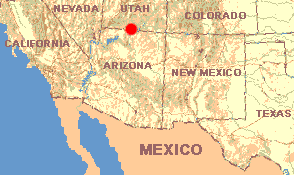 April 8, 1988
April 8, 1988UTAH: Kane County
On western shore of Lake Powerll in Paria Canyon Primitive Area 30 miles northwest of Page, Arizona
 April 8, 1988
April 8, 1988![]() ITEM: BIRDS ON LAKE POWELL
ITEM: BIRDS ON LAKE POWELL
On Radio KPGE out of Page, Arizona, a tourist-oriented blurb describing
Lake Powell says that this reservoir, formed by the damming of the Colorado River by Glen
Canyon Dam, has more shore-line than the U. S.'s entire Pacific Coast; Henry and I now
claim for ourselves part of that shore.
As I type this the lake's dark, ultramarine waters are too glossy and urbane to be pooled below the ancient, gray, vertical-walled and distinctly horizontally layered, flat-topped mesas across the lake. Aesthetically I should prefer to see sagebrush flats where the water is. However, I can't deny that being near water is a relief. Also it's good being where a variety of birds can be spotted.
Fifty feet downshore three Ring-billed Gulls and a Raven stand along the water's edge, eying us as if expecting breadcrumbs to be forthcoming. On a sand spit across the little inlet to our left, a Long-billed Curlew perches on one leg, its beak tucked into the feathers over its shoulder. It's migrating northward, having just spent winter farther south, perhaps in Mexico or along the U. S. coast, and will breed in the North. During these mid-day hours he never moves, except for once when the wind blows him off-balance. Before he returns his outrageously long and slender beak to its resting place, like any good ol' boy, he uses it to scratch his belly.
In the inlet's sheltered waters swim three Buffleheads, who overwinter here and right now must be feeling the urge to migrate to their breeding grounds in Canada or the higher elevations of the Pacific Northwest in the U. S. Just offshore dozens of Coots float among the lake's high waves. About a hundred yards down the beach, forty-three Marbled Godwits with their beaks almost as long as the Long-billed Curlew's pose stiff-legged in a tight, nervous-looking knot, looking every bit the away-from-home migrants they are. Probably they've overwintered on the southern California or Mexican coasts and now are on their way to breed in south-central Canada or the U. S. states adjoining that region.
![]() ITEM: A BEE DRAMA
ITEM: A BEE DRAMA
While walking in the sandy, scrubby desert along Lake Powell I come upon a
bee looking somewhat like a small bumblebee, tugging at something in a hole. Often in
desert country I've seen these holes -- perfectly round, about one-third of an inch wide,
dug straight down and surrounded by darker-looking dirt that clearly has been removed and
scattered as the tunnel was being dug. This bee is buzzing and whirring its wings
furiously. After about a minute the bee seems to give up, for it begins buzzing about the
ground in circles. After a few seconds of this, as if with a new spurt of determination,
it rushes into the hole and completely disappears for about five seconds. Then its
rear-end shows at the surface and with a mighty heave out the whole bee pops, now grasping
another bee! Somehow this second bee escapes. The wind blows it tumbling across the sand
until it grabs a blade of grass, composes itself, and flies away. The first bee now takes
off after it, its fervor apparently undiminished. I've been wondering about this episode.
Social insects strike me as being so programed for doing their duties mechanically and
without interference to other members of the colony that I'm surprised to see this
apparent conflict of wills.
![]() ITEM: MORE WILDFLOWERS
ITEM: MORE WILDFLOWERS
Up the beach in an offroad-vehicle-ravaged gully several interesting
wildflowers are blossoming. Longbeak,
Streptanthus cordatus, seen earlier at the edge of Paria's "gulch
garden" is here. It's interesting because its unopened flower buds are held erect,
its open blossoms are held horizontally, and its maturing fruits hang downward, drooped
close to the inflorescence's peduncle. The Cryptantha, genus Cryptantha,
of the Forget-Me-Not Family, is about a foot tall. Some of its flowers are pale yellow
while others in the same inflorescence are a darker, richer yellow. Each petal bears at
its base a tiny bump, giving the blossom the appearance of possessing low crown, like a
yellow Daffodil. A phacelia I'm unable to identify to species level
bears attractive purple flowers, but what I appreciate most about it is its leaves. When
crushed, they emit a moist, pastoral odor with purple overtones. The handlens shows that
its vegetative parts are covered with tiny hairs mounted with amber-colored glands. A
purple-flowered, velvety-leafed member of the Bean Family, another species of locoweed,
is fairly common here.
One point to make by mentioning these wildflowers is that so far in the Great Basin Desert we've seen very few wildflowers. However, now that we've dropped to about 3700 feet, not only have we dipped below the Sagebrush realm, but also we've jumped forward into spring, to a time when wildflowers are abounding.
![]() ITEM: A SCIENTIFIC ANNOUNCEMENT
ITEM: A SCIENTIFIC ANNOUNCEMENT
Most desert-ecology texts carry in their pages a picture of a profusely
branching bush stabilizing its little corner of the desert. The scenario goes like this:
l) open sand; 2) bush gets established; 3) windblown sand grains collect around the bush,
forming a stabilized mound, and; 4) other plants and animals begin inhabiting the mound,
eventually forming a complex community of interacting organisms. Well, after studying the
phenomenon in four North American deserts, I feel qualified to announce to the world that
the above outline really ought to include more steps than those four. The texts should
begin appending these two final steps: 5) the dome of sand catches the eye of an
off-roader and is used as a jump-ramp; 6) the shattered bush, in this area often a large Mormon
Tea, genus Ephedra, dies back and the community disintegrates...